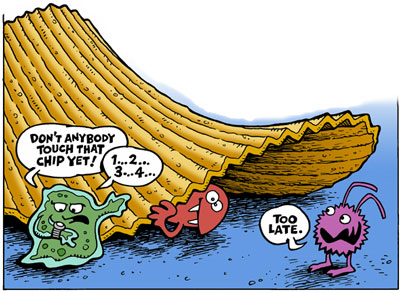Oh no – I dropped my bagel!
Does following the five second rule really keep you safe from harmful bacteria?
We’ve all done it – you drop your chip, bagel, carrot, cookie, whatever food item on the floor – pick it up, wipe it off, and say to yourself “five second rule!” The five second rule is a common practice in which people believe that a dropped piece of food is still safe to eat if it is picked up within five seconds of landing. But is it really safe practice? Let’s first take a look at the history of the rule.
carrot, cookie, whatever food item on the floor – pick it up, wipe it off, and say to yourself “five second rule!” The five second rule is a common practice in which people believe that a dropped piece of food is still safe to eat if it is picked up within five seconds of landing. But is it really safe practice? Let’s first take a look at the history of the rule.
Most historians credit Genghis Kahn, leader of the Mongolian Empire in the early 1200’s, as being the first to create a rule about food falling on the ground. Kahn would have victory banquets after winning conquests and he only had one rule at these affairs: Any food fallen on the floor can stay on the floor for 12 hours or as long as The Great Khan says it can stay on the floor. However, sanitation was not a high priority in those times and anyone who did in fact eat food off the floor was likely to die from it. If you died in this way, it was said you had been “Khanned.” During the time of Michelangelo, the rule was shortened to 25 minutes, or the time it took to descend from the ceiling of the Cistine Chapel to retrieve any food had dropped. During the American Revolution in the 1700’s the rule drastically decreased to one minute, mostly because of dogs hanging around that would scoop up the food if left sitting on the floor. Today the rule generally wavers between three and five seconds.
Luckily, thanks to advances in microbiology, the validity of the five second rule is known.
In 2010 Paul Dawson, a food scientist at Clemson University put the rule to the test. The study compared three surfaces commonly found in households (carpet, wood and tile), and two food items (bologna and bread). The bacteria used in the experiment was a strain of Salmonella. Results showed that bologna picked up 99 percent of harmful bacteria when left on the tile surface for five seconds. Carpet transferred the least amount of bacteria cells.
What about a one second rule you ask? This study also found that bacteria, in high enough concentrations can live up to four weeks on dry surfaces and be transferred to dropped food items immediately on contact. Harley Rotbart, a microbiologist from the University of Colorado, suggests a “zero second rule” when it comes to food, especially in household kitchens. He states that the kitchen floor is likely more dirty and contaminated with hazardous viruses and bacteria than outdoor surfaces like sidewalks.
Michigan State University Extension agrees with Rotbart and suggests throwing away food that has fallen on the floor to protect yourself from harmful pathogens.



 Print
Print Email
Email


